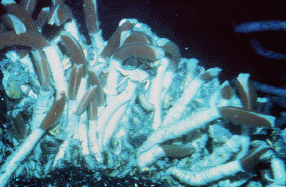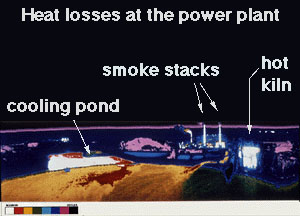Exploratour: Life on Mars?
Click on image for full size
Image copyright 1997 by the American Geophysical Union. Further electronic distribution is not allowed.
Life that Survives in Harsh Environments
So far we've taken a look at what life is and at some of the negative results in looking for life in a Martian meteroid and on the planet itself. It doesn't seem like there is life now on Mars. But maybe there is life that could live in an extreme environment like on Mars...or maybe Mars was different in the past. This is what we'll look at now.On Earth, we know that there are many kinds of life which can survive in difficult environments. An example of one such creature is shown in this picture. These are smokers, which live on the bottom of the ocean floor, under extreme pressure (think of how your ears feel when you dive to the bottom of a deep swimming pool), complete darkness, and very cold temperatures. These creatures survive around ocean vents which supply warmth and food for them.
On Earth, there are many forms of bacteria which can survive in environments without oxygen. It is lifeforms like these that we would expect to find on Mars or other planets with extreme environments.












